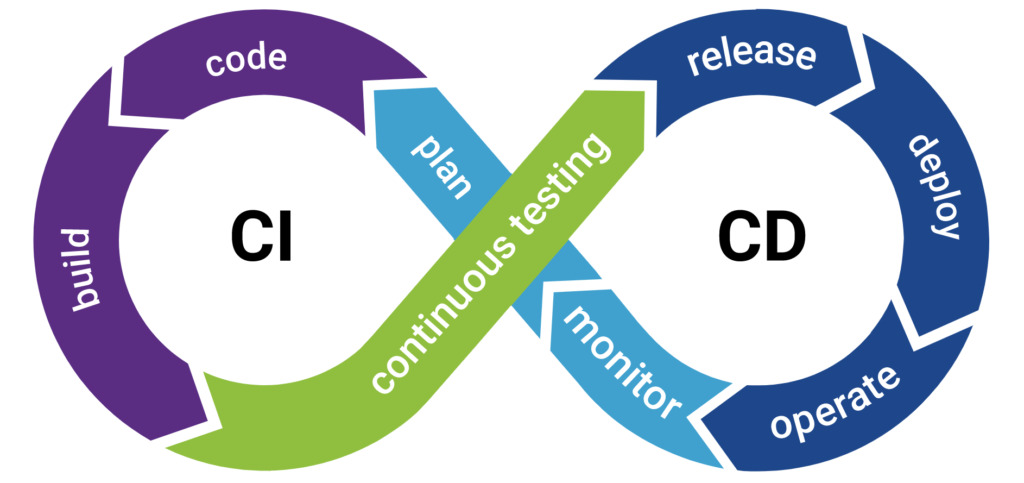
Introduction
Read-Time: 4 min
Category: CI/CD pipeline
Continuous integration and continuous deployment (CI / CD) pipeline Benefits is a set of steps that need to be taken to deploy a new software release. The CI / CD pipeline is a technique focused on improving software delivery throughout the software development life cycle through automation.
By automating CI / CD at each stage of software development lifecycle development, testing, production, and monitoring, enterprises can develop higher-quality code faster. Although it is possible to manually perform each step in the CI / CD pipeline, the true value of the CI / CD pipeline is realized by automation.
In this blog, how to answer questions about “What is the CI / CD pipeline”, CI / CD Pipeline Benefits, CI / CD and traditional development, the features required for the CI / CD pipeline, and what is CI? To learn. / CD security? , CI / CD tools.
What is a CI/CD pipeline?

The Continuous Integration / Continuous Delivery (CI / CD) pipeline is an agile DevOps workflow that focuses on frequent and reliable software delivery processes. This methodology is iterative and non-linear, allowing DevOps teams to write code, integrate, run tests, deploy releases, and deploy changes to software together in real-time.
An important function of the CI / CD pipeline is to use automation to ensure the quality of your code. Use test automation to detect dependencies and other issues early as software changes traverse the pipeline, propagate your code changes to different environments, and deploy your applications to production environments. .. The job of automation here is to perform quality control and evaluate everything from performance to API usage to security. This fully integrates the changes made by all team members and implements them as intended.
The ability to automate various stages of the CI / CD pipeline helps development teams improve quality, speed up their work, and improve other DevOps metrics.
CI/CD pipeline Benefits
The cicd pipeline benefit is to stay competitive in the current market, companies strive to release features as quickly as possible. The platform that optimally realizes these rapid release cycles is the seamless CI / CD pipeline.
The pipeline consists of a set of tools and frameworks that help developers, testers, operations teams, and others involved in the project deliver software to end-users. This gives the team more opportunities to be agile and improves the overall efficiency of the software delivery process.
1. Smaller Backlog
One of the best points of the benefits of the cicd pipeline. By integrating CI / CD into your company’s development process, you can reduce the number of non-critical errors in your backlog. These minor defects are identified and fixed before manufacturing before they are released to end-users. There are many benefits to the early resolution of non-essential issues. For example, developers can spend more time improving their systems by focusing on larger issues, and testers can find larger issues before they are released without having to focus on smaller issues. increase. Another advantage (and perhaps the best) is to satisfy customers by preventing product defects from being found.
2. Faster Release Rate
The Second-way cicd pipeline benefits. Errors are detected faster, so they can be fixed faster, increasing turnaround. However, frequent releases are only possible if the code is being developed on a constantly changing system.
CI/CD continually merges code and, after thorough testing, continually deploys it to production to make the code ready for release. As part of the deployment, it is important to set up a production environment that closely resembles the end-user environment. Containerization is a great way to test your code in production, and only test the areas that will be released.
3. More Test Reliability
The third way of cicd pipeline benefits with, byte size and specific changes introduced to the system improve test reliability and allow for more accurate positive and negative tests. The reliability of the tests in CI / CD can also be considered continuous reliability. With continuous integration and release of new products and features, knowing that quality is a top priority throughout the process ensures that stakeholder investment is well worth it.
4. Reduce Costs
The fourth point cicd pipeline benefits from the way Automation of the CI / CD pipeline reduces the number of errors that can occur in many iterative steps of CI and CD. This frees up developer time for product development, as there aren’t too many code changes to fix later if a bug is found quickly. Another thing to keep in mind is that improving the quality of your code through automation also improves your ROI.
5. Smaller Code Changes
The fifth point of cicd pipeline benefits. One technical advantage of continuous integration and continuous delivery is that it allows you to integrate small pieces of code at one time. These code changes are simpler and easier to handle than huge chunks of code and as such, have fewer issues that may need to be repaired at a later date.
Using continuous testing, these small pieces can be tested as soon as they are integrated into the code repository, allowing developers to recognize a problem before too much work is completed afterward. This works really well for large development teams who work remotely as well as those in-house as communication between team members can be challenging.
Needed capabilities in a CI/CD pipeline
- Eliminates errors caused by manual task execution.
- It provides a standardized development feedback loop.
- Allows rapid product iteration
The CI / CD pipeline automates the following steps in the software delivery process. Start a code build, run automated tests, deploy your infrastructure, and deploy it to your staging or production environment. Creating such a fully automated CI / CD pipeline requires tools with specific skills. Which tools and features you need depend on your CI / CD pipeline environment and the architecture you choose. CICD Pipeline Benefits
- Continuous Integration
- version control and configuration management for maintaining the different versions of the code.
- compiler.
- validation.
- code review (automated and through “pull request”).
- unit testing.
- integration testing.
- containerization (packaging).
- Continuous delivery
- Configuration management.
- User acceptance test.
- Deploy the build application (container, package).
- Automatic check and verification for automatic deployment approval.
- Continuous monitoring
- Monitoring to ensure that the application is working properly.
- Alert management to get the right people’s attention when a particular event occurs in any of your DevOps activities.
- Analysis to identify problems in your code and perform root cause analysis.
- Team telemetry to understand the maturity of a team and how it can be improved.
- Live site telemetry for measuring system execution, platform activity, and management logs.
- Cognitive monitoring automates and improves IT operations by applying machine learning to log data.Security monitoring to monitor security threats. User telemetry to measure user emotions and behavior.
- Continuous quality and testing
- Automatic provision of test environment using test data.
- Automated test execution.
- Automatic detection of abnormalities.
- A workflow that supports risk-related anomaly severity/priority assignments.
- AI and ML technology for continuous and automated optimization of test sets.
- Continuous visibility of quality status across the CI / CD pipeline. CI / CD tool
CI/CD tooling
Bamboo

Bamboo Server uses the power of automation, integration, and workflow management to help DevOps and CI / CD teams streamline software development and delivery. It is part of Atlassian’s product ecosystem and can be used in combination with Bitbucket’s code pipeline.
Docker

Docker is a widely used containerization solution for DevOps and CI / CD workflows. You can use this tool to disconnect your app from the environment. It also comes with an off-the-shelf community of container images for development.
GitLab

GitLab is a collection of tools intended for use in different phases of the software development life cycle. At its core is a Git repository manager designed for use on the web, with features such as problem tracking, reporting, and online wikis.
Harness

As a continuous self-service integration and delivery platform, Harness enables engineers and DevOps to build, test, deploy, and validate software on demand. Harnesses simplify feature flags, cloud cost optimization, and many other CI / CD processes thanks to the industry’s first AI-powered software delivery platform.
Jenkins

Jenkins is an open-source server for automation that is free to use. In software development, it aids in the automation of the processes associated with creating, testing, and deploying, hence helping the methods of continuous integration and delivery. In this case, it is a server-based solution that operates in servlet containers such as the Apache Tomcat web server.
Conclusion
Continuous integration and continuous delivery provide the ideal scenario for enterprise application teams. Developers simply push the code to the repository. This code is subject to integration, testing, deployment, retesting, merging with infrastructure, security, and quality checks, and can be deployed with extremely high reliability.
With CI / CD, you can be confident that your code will be better quality, software updates will be deployed quickly, and there will be no significant changes. Release impacts can be correlated with production and operational data. It can also be used to plan the next cycle. This is a key DevOps practice in your organization’s cloud transformation.
Frequently Asked Questions
Q1 What is the build stage?
The build phase builds the project’s binaries, containers, or executable programs. This phase verifies that the application is buildable and provides testable artifacts.
Q2 What is the main difference between BDD and TDD?
If TDD is to design the right thing, Behavior-Driven Development (BDD) is to design the right thing. Like TDD, BDD starts with testing, but the main difference is that testing BDD is a scenario that explains how the system responds to user interaction.When creating BDD tests, developers and testers are interested in behavior (feature behavior), not technical details (feature behavior). BDD testing is used to test and discover features that bring maximum value to users.
Q3 What is a Git branch?
A Git branch is a separate development line, usually created to work with features. Branches allow developers to code without affecting the work of other team members.
Q4 What is a Git repository?
The Git repository keeps track of all the files in your software project. The repository acts as an index for all files and changes in your project, allowing developers to move to any point in the project history.












